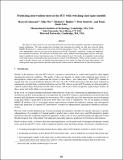Predicting intervention onset in the ICU with switching state space models.
Author(s)
Ghassemi, Marzyeh; Wu, M.; Hughes, M.; Doshi-Velez, F.
DownloadAccepted version (380.5Kb)
Terms of use
Metadata
Show full item recordAbstract
The impact of many intensive care unit interventions has not been fully quantified, especially in heterogeneous patient populations. We train unsupervised switching state autoregressive models on vital signs from the public MIMIC-III database to capture patient movement between physiological states. We compare our learned states to static demographics and raw vital signs in the prediction of five ICU treatments: ventilation, vasopressor administra tion, and three transfusions. We show that our learned states, when combined with demographics and raw vital signs, improve prediction for most interventions even 4 or 8 hours ahead of onset. Our results are competitive with existing work while using a substantially larger and more diverse cohort of 36,050 patients. While custom classifiers can only target a specific clinical event, our model learns physiological states which can help with many interventions. Our robust patient state representations provide a path towards evidence-driven administration of clinical interventions.
Date issued
2017-03Department
Massachusetts Institute of Technology. Computer Science and Artificial Intelligence LaboratoryJournal
AMIA Joint Summit
Publisher
American Medical Informatics Association
Citation
Ghassemi, M., M. Wu, M. Hughes, and F. Doshi-Velez, "Predicting intervention onset in the ICU with switching state space models." AMIA Joint Summit 2017, March 27-30, 2017, San Francisco, California. url https://www.amia.org/jointsummits2017/papers
Version: Author's final manuscript